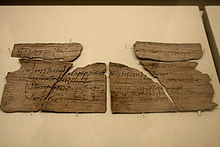
Vindolanda was a Roman auxiliary fort (castrum) just south of Hadrian's Wall in northern England, which it pre-dated. Archaeological excavations of the site show it was under Roman occupation from roughly 85 AD to 370 AD. Located near the modern village of Bardon Mill in Northumberland, it guarded the Stanegate, the Roman road from the River Tyne to the Solway Firth. It is noted for the Vindolanda tablets, a set of wooden leaf-tablets that were, at the time of their discovery, the oldest surviving handwritten documents in Britain.

The Roman conquest of Britain was the Roman Empire's conquest of most of the island of Britain, which was inhabited by the Celtic Britons. It began in earnest in AD 43 under Emperor Claudius, and was largely completed in the southern half of Britain by AD 87, when the Stanegate was established. The conquered territory became the Roman province of Britannia. Attempts to conquer northern Britain (Caledonia) in the following centuries were not successful.
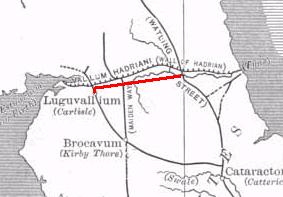
The Stanegate was an important Roman road and early frontier built in what is now northern England. It linked many forts including two that guarded important river crossings: Corstopitum (Corbridge) on the River Tyne in the east and Luguvalium (Carlisle) in the west. The Stanegate ran through the natural gap formed by the valleys of the River Tyne in Northumberland and the River Irthing in Cumbria. It predated the Hadrian's Wall frontier by several decades; the Wall would later follow a similar route, albeit slightly to the north.
The gens Sulpicia was one of the most ancient patrician families at ancient Rome, and produced a succession of distinguished men, from the foundation of the Republic to the imperial period. The first member of the gens who obtained the consulship was Servius Sulpicius Camerinus Cornutus, in 500 BC, only nine years after the expulsion of the Tarquins, and the last of the name who appears on the consular list was Sextus Sulpicius Tertullus in AD 158. Although originally patrician, the family also possessed plebeian members, some of whom may have been descended from freedmen of the gens.

The Revolt of the Batavi took place in the Roman province of Germania Inferior between AD 69 and 70. It was an uprising against the Roman Empire started by the Batavi, a small but militarily powerful Germanic tribe that inhabited Batavia, on the delta of the river Rhine. They were soon joined by the Celtic tribes from Gallia Belgica and some Germanic tribes.
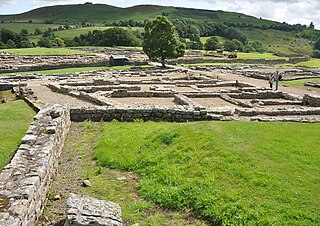
Claudia Severa was a literate Roman woman, the wife of Aelius Brocchus, commander of an unidentified fort near Vindolanda fort in northern England. She is known for a birthday invitation she sent around 100 AD to Sulpicia Lepidina, wife of Flavius Cerialis, commander at Vindolanda. This invitation, written in ink on a thin wooden tablet, was discovered in the 1970s and is probably the best-known item of the Vindolanda Tablets.
Lucius Neratius Marcellus was an imperial Roman military officer and senator who held a number of posts in the Emperor's service. Marcellus was elected consul twice, first under Domitian in 95 AD and again under Hadrian in 129. His life provides several examples of how patronage operated in early Imperial Rome.
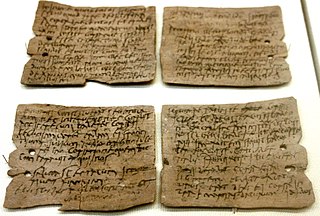
The Vindolanda tablets are some of the oldest surviving handwritten documents in Britain. They are a rich source of information about life on the northern frontier of Roman Britain. Written on fragments of thin, postcard-sized wooden leaf-tablets with carbon-based ink, the tablets date to the 1st and 2nd centuries AD. Although similar records on papyrus were known from elsewhere in the Roman Empire, wooden tablets with ink text had not been recovered until 1973, when archaeologist Robin Birley, his attention being drawn by student excavator Keith Liddell, discovered some at the site of Vindolanda, a Roman fort in northern England.
Luguvalium was an ancient Roman city in northern Britain located within present-day Carlisle, Cumbria, and may have been the capital of the 4th-century province of Valentia. It was the northernmost city of the Roman Empire.
The Minimus books are a series of school textbooks, written by Barbara Bell, illustrated by Helen Forte, and published by the Cambridge University Press, designed to help children of primary school age to learn Latin. The books espouse some of the principles of the direct method of language teaching, and feature a mouse of the same name; minimus is (Latin for "smallest", and also a pun on mus — Latin for "mouse". Minimus is known by the publisher as "the mouse that made Latin cool". There are two books in the series: Minimus: Starting out in Latin and Minimus Secundus. The first book is aimed at 7- to 10-year-olds, and the second continues the education for children up to 13 years old.

A birthday card is a greeting card given or sent to a person to celebrate their birthday. Sufiya Similar to a birthday cake, birthday card traditions vary by culture but the origin of birthday cards is unclear. The advent of computing and introduction of the internet and social media has led to the use of electronic birthday cards or even Facebook posts to send birthday messages.

Pons Aelius, or Newcastle Roman Fort, was an auxiliary castra and small Roman settlement on Hadrian's Wall in the Roman province of Britannia Inferior, situated on the north bank of the River Tyne close to the centre of present-day Newcastle upon Tyne, and occupied between the 2nd and 4th centuries AD.
The overall size of the Roman forces in Roman Britain grew from about 40,000 in the mid 1st century AD to a maximum of about 55,000 in the mid 2nd century. The proportion of auxiliaries in Britain grew from about 50% before 69 AD to over 70% in c. 150 AD. By the mid-2nd century, there were about 70 auxiliary regiments in Britain, for a total of over 40,000 men. These outnumbered the 16,500 legionaries in Britain by 2.5 to 1. This was the greatest concentration of auxilia in any single province of the Roman Empire. It implies major continuing security problems; this is supported by the (thin) historical evidence. After Agricola, the following emperors conducted major military operations in Britain: Hadrian, Antoninus Pius, Septimius Severus, and Constantius I.

Uxelodunum was a Roman fort with associated civilian settlement (vicus) in modern-day Carlisle, Cumbria, England. It was the largest fort on Hadrian's Wall and is now buried beneath the suburb of Stanwix.

Hadrian's Wall is a former defensive fortification of the Roman province of Britannia, begun in AD 122 in the reign of the Emperor Hadrian. Running from Wallsend on the River Tyne in the east to Bowness-on-Solway in the west of what is now northern England, it was a stone wall with large ditches in front and behind, stretching across the whole width of the island. Soldiers were garrisoned along the line of the wall in large forts, smaller milecastles, and intervening turrets. In addition to the wall's defensive military role, its gates may have been customs posts.
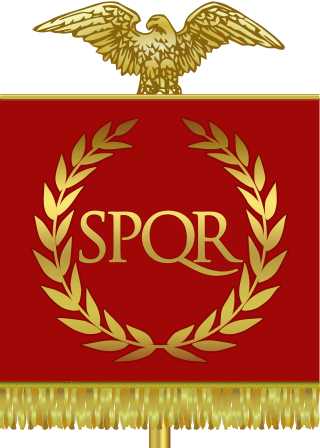
The Imperial Roman Army was the military land force of the Roman Empire from 27 BC to 476 AD, and the final incarnation in the long history of the Roman army. This period is sometimes split into the Principate and the Dominate (284–476) periods.
The Cohors VI Nerviorum was an auxiliary unit of Roman Army Cohors quinquagenaria peditata type attested in the Roman province of Britannia from the second century to the early fifth century AD.

Milecastle 59 (Old Wall) was a milecastle on Hadrian's Wall (grid reference NY48546174).
Titus Haterius Nepos was an eques who held a number of imperial Roman positions during the reigns of Trajan and Hadrian. The two most important posts were praefectus vigilum or commander of the vigiles or nightwatch, and praefectus or governor of Egypt (120-124). According to Fergus Millar, Nepos was the first eques who was promoted from regular procuratorial posts into a proper secretarial appointment.
